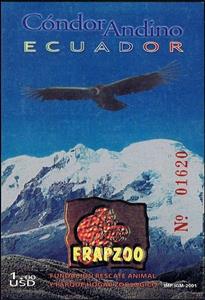Souvenir Sheet: Animal Welfare Organization FRAPZOO - Andean Condor 2001 (Ecuador 2001)
Animal Welfare Organization FRAPZOO - Andean Condor 2001 (Ecuador 2001)
23 July (Ecuador ) within release Animal Welfare Organization FRAPZOO - Andean Condor 2001 goes into circulation Souvenir Sheet Animal Welfare Organization FRAPZOO - Andean Condor 2001 face value 1 United States dollar
| Souvenir Sheet Animal Welfare Organization FRAPZOO - Andean Condor 2001 in catalogues | |
|---|---|
| Michel: | Mi: EC BL164 |
| Stamp Number: | Sn: EC 1577 |
Souvenir Sheet is vertical format.
Also in the issue Animal Welfare Organization FRAPZOO - Andean Condor 2001:
- Stamp - Animal Welfare Organization FRAPZOO - Andean Condor 2001 face value 0.86;
- Stamp - Animal Welfare Organization FRAPZOO - Andean Condor 2001 face value 0.86;
- Souvenir Sheet - Animal Welfare Organization FRAPZOO - Andean Condor 2001 face value 1;
Souvenir Sheet Animal Welfare Organization FRAPZOO - Andean Condor 2001 it reflects the thematic directions:
Animals are multicellular, eukaryotic organisms of the kingdom Animalia (also called Metazoa). All animals are motile, meaning they can move spontaneously and independently, at some point in their lives. Their body plan eventually becomes fixed as they develop, although some undergo a process of metamorphosis later on in their lives. All animals are heterotrophs: they must ingest other organisms or their products for sustenance.
Birds (Aves), a subgroup of Reptiles, are the last living examples of Dinosaurs. They are a group of endothermic vertebrates, characterised by feathers, toothless beaked jaws, the laying of hard-shelled eggs, a high metabolic rate, a four-chambered heart, and a strong yet lightweight skeleton. Birds live worldwide and range in size from the 5 cm (2 in) bee hummingbird to the 2.75 m (9 ft) ostrich. They rank as the class of tetrapods with the most living species, at approximately ten thousand, with more than half of these being passerines, sometimes known as perching birds. Birds are the closest living relatives of crocodilians.
Birds of prey or predatory birds, also known as raptors, are hypercarnivorous bird species that actively hunt and feed on other vertebrates (mainly mammals, reptiles and smaller birds). In addition to speed and strength, these predators have keen eyesight for detecting prey from a distance or during flight, strong feet with sharp talons for grasping or killing prey, and powerful, curved beaks for tearing off flesh. Although predatory birds primarily hunt live prey, many species (such as fish eagles, vultures and condors) also scavenge and eat carrion
A vulture is a bird of prey that scavenges on carrion. There are 23 extant species of vulture (including condors). Old World vultures include 16 living species native to Europe, Africa, and Asia; New World vultures are restricted to North and South America and consist of seven identified species, all belonging to the Cathartidae family. A particular characteristic of many vultures is a bald, unfeathered head. This bare skin is thought to keep the head clean when feeding, and also plays an important role in thermoregulation




